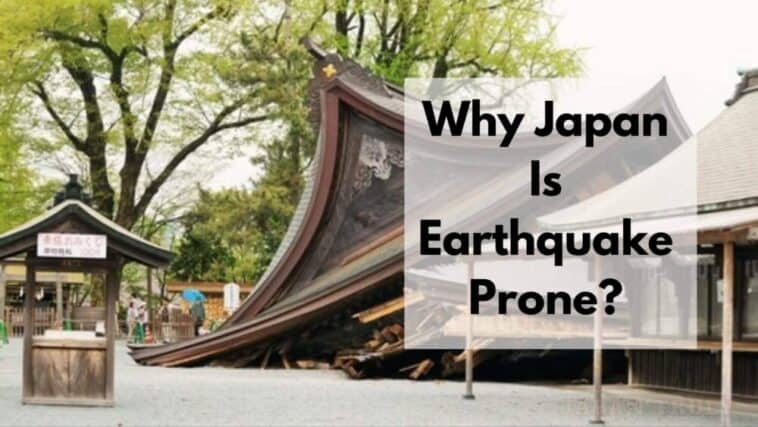Did you know Japan is a country that’s prone to Earthquakes. Read on to find out why Japan is earthquake prone. Read on!
Japan’s susceptibility to earthquakes stems from its position atop several converging tectonic plates, where immense subterranean forces meet.
This geological hotbed is a crucible for seismic activity, making the nation one of the most earthquake-prone areas on Earth, with a history of both frequent and powerful tremors.
Page Contents
Why is Japan Earthquake Prone?
Japan is earthquake-prone due to its location on the Pacific Ring of Fire, where multiple tectonic plates, including the Pacific Plate and Philippine Sea Plate, converge and interact.

This tectonic activity generates frequent seismic events, making earthquakes a common occurrence throughout the archipelago.
Why Are Earthquakes Frequent In Japan?
The reason why Japan experiences frequent earthquakes and tremors is due to geographical reasons.
If you take a look at the world map you’ll spot Japan in the southeast part of Asia that’s along the Pacific Ring of Fire.
Now Pacific Ring of Fire is the spot on Earth where most volcanoes are active and the place where frequent earthquakes are proved to occur, thus the reason behind such a name.
Right beneath the Pacific Ring of Fire lies several tectonic plates which include Pacific Plate, Indian Australian Plate, Philippine Plate, North American Plate, Nazca Plate, etc.
With that many tectonic plates in place, it’s only understandable that the frequent movements of plates cause major earthquakes in Japan and any other country in the location of the Ring of Fire.
Over 90% of the Earth’s earthquakes are proven to occur in the Ring of Fire location and since Japan is exactly in that location, earthquakes are much more common over there.
The area in Japan that’s more exposed to these terrifying tremors is Tokyo and its suburbs. This is due to the three tectonic plates Pacific, North American, and Philippine constantly shifting and causing intense quakes on Japan’s east coast.
With constant seismic events occurring in Japan frequently the probability of sudden tsunami or tidal waves are also high in the nation.
Interesting And Unknown Facts About Earthquakes In Japan
Let’s take a look at some of the other intriguing and uncommon facts about earthquakes in Japan.
- Tokyo is the only city in the world that’s more prone to any natural disasters.
- Japan uses a separate scale to measure the intensity of earthquakes rather than the Richter scale. This scale is called the Shindo scale and it’s used by Japan Meteorological Agency (JMA). The maximum level of this scale is magnitude 7 whereas the upper limit for the Richter scale is between magnitude 8 to 9.
- An earthquake is declared fatal when it scores magnitude 5 on the Shindo scale and above magnitude 7 on the Richter scale. With such magnitudes, the earthquake would be deadly enough to collapse over 100s of buildings, uproot trees and cause enormous cracks on the surface.
- The greatest earthquake in Japan measured at magnitude 7 on the Shindo scale and magnitude 6.9 on the Richter scale occurred in 1995 and the seismic event was called the Great Hanshin Earthquake.
- 20% of the major earthquakes on Earth that are above 6 magnitudes are proven to occur in Japan.
- Over the last few decades, Japan experienced some of the most catastrophic earthquakes than any other country.
- The energy released after earthquakes is mostly traced around the areas and borders of Japan.
- Above 1500 minor earthquakes that can be felt are said to occur in Japan on a daily basis.
- Japan’s location along the Ring of Fire is why there are several high mountains and natural hot springs in the country.
- According to Japanese mythology, a large catfish named Namazu is the reason behind constant earthquakes in the region. It’s believed that when Namazu escaped from a god named Kashima, it struggled violently and caused intense shocks beneath Earth.
Seismic Intensity Scale in Japan (Shindo Scale)
The Japan Meteorological Agency (JMA) Seismic Intensity Scale which is also known as the Shindo scale is the widely used scale in Japan to measure the magnitude and the impact of earthquakes.
As we mentioned above, the upper limit of the Shindo scale is 7 magnitudes, and each magnitude represents the intensity of an earthquake as shown below:
0 – Weak tremors that generally go unnoticed.
1 – A slight tension is felt, especially for people who’re indoors.
2 – A minimal shake that causes photos on the wall, lights, etc to vibrate.
3 – A rather light shake which can cause power outages and furniture to shake.
4 – Tremors that are strong enough for people to feel and can cause furniture and appliances to fall.
Lower 5 – Any light or unsupported item can topple and people would panic due to the constant shakes.
Upper 5 – People find it difficult to run or hide under something as heavy furniture may fall and walls may being to crack.
Lower 6 – Any fragile items like glass windows and doors may crack, and people cannot move due to the violent tremors.
Upper 6 – Walls may collapse and people will find it difficult to walk or run.
7 – The highest magnitude on the scale which means the earthquake is very fatal and can cause entire buildings to collapse resulting in displacements of household appliances, and even casualties.
Intense Earthquakes That Have Occured In Japan So Far
Since we know Japan and earthquakes go hand in hand with each other, it isn’t surprising there have been intense earthquakes in the nation that are responsible for countless deaths and displacements.
Let’s take a look at some of the fatal earthquakes that have struck Japan so far.
Meiji Sanriku Earthquake (magnitude 8.5)
This catastrophic earthquake occurred in 1896 in the offshores and the countless aftershocks it caused measured over magnitude 5 and ultimately caused a tsunami that claimed the lives of over 27000 people.
SW Honshu (magnitude 6.9)
This earthquake struck the areas of Kobe, Nishinomiya, and Awaji-Shima in 1995 and the depth of the seismic event was 52km. The number of casualties was estimated to be over 5000 people.
Hoei Earthquake (magnitude 8.6)
This occurred in 1707 which was a dark period for the Japanese people as they constantly kept experiencing earthquakes and aftershocks. Reportedly over 5000 people died during this cataclysmic event.
Tohoku Earthquake (magnitude 9)
One of the biggest earthquakes to occur in past and recent history. Tohoku earthquake occurred in 2011 and it caused multiple damages to the infrastructure in Japan due to a deadly tsunami along with continuous aftershocks above magnitude 7.
There have been countless other earthquakes that have struck Japan with either low or high magnitudes, however, the casualties remain low and the damages aren’t quite significant compared to these catastrophic earthquakes.
Types of Earthquakes That Have Struck Japan
Of the uncountable earthquakes that have occurred in Japan, there are 2 types that have occurred the most, they’re Inland Earthquakes and Ocean Trench Earthquakes.
Inland earthquakes are earthquakes that occur on land due to shocks between plates and this type of earthquake isn’t as common as ocean trench earthquakes.
However, inland earthquakes can be detrimental because most of the damage would be caused on land which can result in collapsing buildings and surface cracks.
Meanwhile, ocean trench quakes initially occur to form mountains in the ocean where old tectonic plates are pushed below other plates hence creating mountains in the oceans that can form volcanoes and even cause earthquakes when the plates move vigorously.
How Japan Copes With Earthquakes?
The Japanese are creative people hence they’ve taken the best measures to cope with frequent earthquakes professionally. Japan has been able to reduce the number of casualties by practicing certain maneuvers such as:
Easy Access To Handy Survival Kits In Japan
In every building in Japan, you’ll find survival kits in place in case of an emergency situation like sudden earthquakes. These survival kits consist of items such as water, medicines, day rations, first aid, insulation sheets, and certain tools. You’ll be able to find these survival kits in several stores in Japan.
Japan Educates About Disaster Prevention Methods
Children in Japan are taught how to cope with earthquakes from a very small age. Every month the children in schools participate in earthquake drills where teachers educate children on how to act when an earthquake hits and how they should stay safe in such panicking situations.
Japan Has Constant Seismometer Surveillance
Japan has developed and installed over 1000s of seismometers across the country. If an earthquake were to strike, the seismometers would detect it and send signals to phones, radio stations, television channels, and every communication channel to alert people to evacuate.
Japan Constructs Buildings With Strong Foundations
Living in a country with frequent earthquakes it’s only sensible to build lifelong earthquake-resistant buildings that don’t collapse easily. Hence most high-rise buildings in Japan have built profound deep foundations and the buildings are also made with Teflon which wouldn’t collapse after a deadly tremor.
Japan Has Synced its Bullet Trains And Seismometers
Bullet trains are the most commonly used public transportation in Japan and connecting them to the country’s seismometers causes the trains to halt during an earthquake after a signal is given, hence passengers can get out of the train on time without any injuries.
Why Japan Is Earthquake Prone: FAQs
Why is Japan the most earthquake-prone country?
Japan is the most earthquake-prone country because its geographical location is right along the Pacific Ring of Fire. The Pacific Ring of Fire is the location on Earth where the most earthquakes and volcanoes are proved to occur. Since several tectonic plates and ocean trenches are located in this particular location, earthquakes are quite frequent in Japan.
How prone is Japan to earthquakes?
Japan is relatively a small island nation with only 0.25% of land and its located very close to the Pacific Ring of Fire. Since the Ring of Fire is where most active volcanoes and earthquakes occur, Japan is prone to earthquakes. Over 19% of the world’s earthquakes occur in Japan.
Does Japan have earthquakes every day?
Japan’s location is in proximity to the Pacific Ring of Fire where most of the world’s tectonic plates are in place. Due to this, several earthquakes occur in Japan every year minor tremors are experienced by the Japanese people on a daily basis.
Related: List of Japanese Historical Periods





